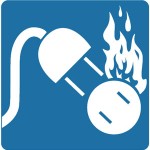Fire Extinguisher Basics


In order to best understand the ingredients necessary for most fires, businesses and fire professionals alike refer to the fire triangle.
Also referred to as the combustion triangle, this model displays how any fire requires three main ingredients: Fuel, heat and an oxidizing agent, which is most often oxygen. Fires are started when these three elements occur at once, and can be extinguished by removing any one of the combustion ingredients
Adding a fourth layer to the fire triangle, the fire tetrahedron displays the fuel, heat, oxidizing agent, and chemical reaction necessary for combustion. Fire suppressant agents like Halon can interfere directly with the chemical reaction occurring in the fire, and help to extinguish it. This method of fire suppression is great for fires sensitive to other typical extinguishing agents, such as water.
One or more of the National Fire Protection Association’s fire symbols should be displayed on a fire extinguisher’s nameplate at all times. These symbols specify which class of fire the extinguisher is effective on, with a red slash indicating the fires it is not effective on. Here are how the different classes break down:

Class “A” These fires involve the most typical combustible materials, such as paper, cloth, rubber, and plastics.

Class “B” This type of fire is associated with flammable liquids, like oils, gasoline, propane, paints, and more. These fires occur from the vapors produced by these flammable liquids.

Class “C” For environments that involve large electrical equipment systems, these extinguishers utilize a non-conductive fire suppression agent.

Class “D” Specialized for unique metals like titanium and magnesium, this class of fire suppressant requires special non-reactive chemical agents that put out the fire without potentially causing a further reaction that could intensify the flames.

Class “K” Designed for fires started by cooking media like oils and animal fats, these extinguishers use a wet chemical agent to both suppress and cool the flames below the auto ignition point.

